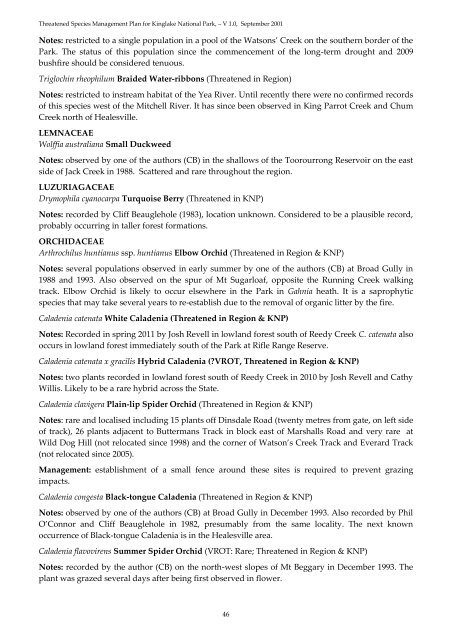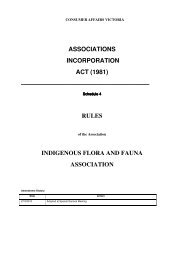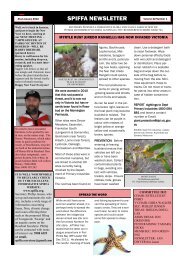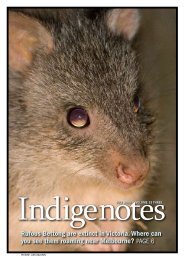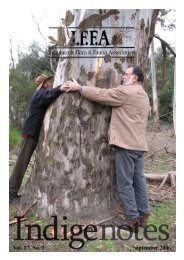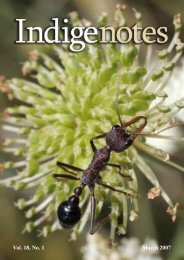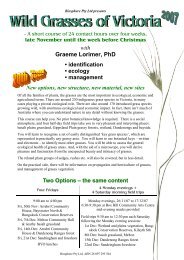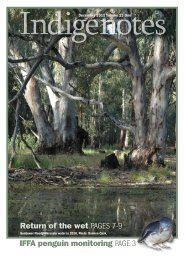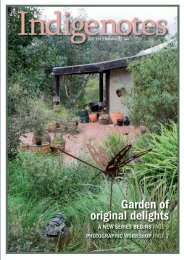Threatened Species Management Plan for Kinglake National Park
Threatened Species Management Plan for Kinglake National Park
Threatened Species Management Plan for Kinglake National Park
Create successful ePaper yourself
Turn your PDF publications into a flip-book with our unique Google optimized e-Paper software.
<strong>Threatened</strong> <strong>Species</strong> <strong>Management</strong> <strong>Plan</strong> <strong>for</strong> <strong>Kinglake</strong> <strong>National</strong> <strong>Park</strong>, – V 1.0, September 2001<br />
Notes: restricted to a single population in a pool of the Watsons’ Creek on the southern border of the<br />
<strong>Park</strong>. The status of this population since the commencement of the long-term drought and 2009<br />
bushfire should be considered tenuous.<br />
Triglochin rheophilum Braided Water-ribbons (<strong>Threatened</strong> in Region)<br />
Notes: restricted to instream habitat of the Yea River. Until recently there were no confirmed records<br />
of this species west of the Mitchell River. It has since been observed in King Parrot Creek and Chum<br />
Creek north of Healesville.<br />
LEMNACEAE<br />
Wolffia australiana Small Duckweed<br />
Notes: observed by one of the authors (CB) in the shallows of the Toorourrong Reservoir on the east<br />
side of Jack Creek in 1988. Scattered and rare throughout the region.<br />
LUZURIAGACEAE<br />
Drymophila cyanocarpa Turquoise Berry (<strong>Threatened</strong> in KNP)<br />
Notes: recorded by Cliff Beauglehole (1983), location unknown. Considered to be a plausible record,<br />
probably occurring in taller <strong>for</strong>est <strong>for</strong>mations.<br />
ORCHIDACEAE<br />
Arthrochilus huntianus ssp. huntianus Elbow Orchid (<strong>Threatened</strong> in Region & KNP)<br />
Notes: several populations observed in early summer by one of the authors (CB) at Broad Gully in<br />
1988 and 1993. Also observed on the spur of Mt Sugarloaf, opposite the Running Creek walking<br />
track. Elbow Orchid is likely to occur elsewhere in the <strong>Park</strong> in Gahnia heath. It is a saprophytic<br />
species that may take several years to re-establish due to the removal of organic litter by the fire.<br />
Caladenia catenata White Caladenia (<strong>Threatened</strong> in Region & KNP)<br />
Notes: Recorded in spring 2011 by Josh Revell in lowland <strong>for</strong>est south of Reedy Creek C. catenata also<br />
occurs in lowland <strong>for</strong>est immediately south of the <strong>Park</strong> at Rifle Range Reserve.<br />
Caladenia catenata x gracilis Hybrid Caladenia (?VROT, <strong>Threatened</strong> in Region & KNP)<br />
Notes: two plants recorded in lowland <strong>for</strong>est south of Reedy Creek in 2010 by Josh Revell and Cathy<br />
Willis. Likely to be a rare hybrid across the State.<br />
Caladenia clavigera Plain-lip Spider Orchid (<strong>Threatened</strong> in Region & KNP)<br />
Notes: rare and localised including 15 plants off Dinsdale Road (twenty metres from gate, on left side<br />
of track), 26 plants adjacent to Buttermans Track in block east of Marshalls Road and very rare at<br />
Wild Dog Hill (not relocated since 1998) and the corner of Watson’s Creek Track and Everard Track<br />
(not relocated since 2005).<br />
<strong>Management</strong>: establishment of a small fence around these sites is required to prevent grazing<br />
impacts.<br />
Caladenia congesta Black-tongue Caladenia (<strong>Threatened</strong> in Region & KNP)<br />
Notes: observed by one of the authors (CB) at Broad Gully in December 1993. Also recorded by Phil<br />
O’Connor and Cliff Beauglehole in 1982, presumably from the same locality. The next known<br />
occurrence of Black-tongue Caladenia is in the Healesville area.<br />
Caladenia flavovirens Summer Spider Orchid (VROT: Rare; <strong>Threatened</strong> in Region & KNP)<br />
Notes: recorded by the author (CB) on the north-west slopes of Mt Beggary in December 1993. The<br />
plant was grazed several days after being first observed in flower.<br />
46


